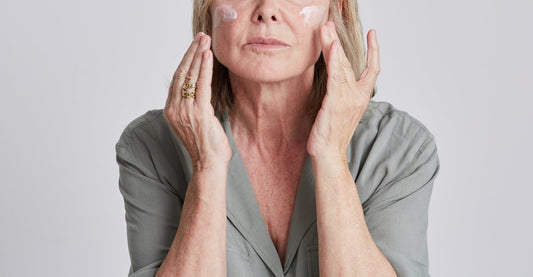What perfectly normal, age-related condition has 34 recognized symptoms and affects only women? If you guessed menopause, you’re correct.1 But if you’re currently experiencing symptoms that range from minor annoyances to life-altering changes during perimenopause, menopause, or postmenopause, you may not feel much like celebrating.
Hot flashes and night sweats are often talked about—but what about the other 32 recognized symptoms of menopause? Let's take a look at one common menopausal issue that doesn't get much attention: thin, flaking, brittle nails.
Menopause and Nail Health
Aging adults in general—but menopausal women in particular—may experience dry, brittle nails that sometimes crack or split. Weak nails can also peel or chip easily, and vertical ridges (called onychorrhexis) on the nail can sometimes occur. Cuticles can be affected by dryness experienced in the skin as well, which means hangnails can also become more problematic during menopause.2 That’s a lot of trauma confined to just our hands. So, why exactly does this happen and what can you do about it?
The Estrogen Effect
As with most changes occurring in the body during menopause, hormone fluctuations are the culprit for this symptom. When estrogen levels begin to decrease during perimenopause, one of the many consequences is that the body regulates fluids less efficiently.3 This often results in dehydration, which can affect the amount of keratin—the protein that makes up nails, hair and skin—that our bodies produce. When nail layers weaken due to inadequate amounts of keratin, they may become brittle and chip, flake, or split.4
Although affected nails typically won’t look as smooth and healthy as they once did, don’t worry. There are several steps you can take to combat dry, brittle nails during menopause and beyond.
Keeping Nails Strong
If you’ve experienced dry, brittle nails during menopause, lifestyle changes and products specifically designed to treat the issue may help. Here are a few ways you can pamper your nails during these transitional years.
Stay Hydrated
Drink plenty of water to maintain fluid balance. Aim for 8, eight-ounce glasses each day (about 2 liters)—more if you’re exercising or it's warm outside. Coffee and tea can contribute to your daily water intake, too, as long as they’re consumed in moderation. Be sure to remain conscious of your caffeine intake overall, as it is a known diuretic and can contribute to increased dehydration.5
Moisturize, Moisturize, Moisturize
High-quality moisturizers can help keep your hands and nails from drying out, so use them as you go about your day, as frequently as needed. Just be sure to look out for and avoid products that contain harsh chemicals—instead, consider moisturizers that contain shea butter or avocado oil in their ingredients. Additionally, the best time to use a moisturizer is after the skin is exposed to water, so apply right after washing your hands or taking a shower to help prevent dry, brittle nails and to lock in moisture.6
Check Your Diet
It’s important to eat healthy meals and snacks during menopause to help maintain your overall health and wellness. Certain foods, however, do contain nutrients necessary for nail growth, so try to incorporate these in your diet regularly: 7
- Seafood – which contains zinc, a necessary nutrient for cell growth
- Fresh fruit – those containing vitamin C, which can prevent nails from becoming brittle
- Eggs – a protein-rich food which can help increase nail strength
- Peanuts – which contain biotin (vitamin B7); 2.5 mg of biotin per day can increase the firmness of nails8
Calcium and vitamin D are also important for supporting good nail health. If you aren’t getting enough of these through the foods you eat, consider talking with your healthcare provider about adding a dietary supplement to your diet.9
Avoid Damage
Thin, brittle nails may break or split easily. Fortunately, there are several things you can do to avoid physically stressing weak nails during menopause: 10
- Keep nails short – they will be less prone to break when bumped or if they catch on clothing.
- Wear gloves – during household chores and outdoor tasks/activities to protect your hands and nails from any damage.
- Use nail polish or get a manicure – this will add a protective layer to your nails that may help with breaking or chipping. Certain types of manicures, like gel and dip powder, are long-lasting and durable, providing even greater protection for your nails - but beware, as longer term use of these types of treatments can be damaging to nails for some women.
- Be careful with polish removers – consider not using nail polish removers with the chemical acetone, which dries nails out.
While it’s very common for menopausal women to experience thin, brittle nails, it’s good to be aware of ways to combat this unwelcomed change. Hopefully these techniques will help your nails maintain—or even regain—their strength and beauty as you age.
Resources
- https://www.medicalnewstoday.com/articles/what-are-the-34-symptoms-of-menopause
- https://menopause.livebetterwith.com/blogs/stories-info/brittle-nails-in-menopause-what-can-help
- https://www.ncbi.nlm.nih.gov/pmc/articles/PMC3984489/
- https://menopause.livebetterwith.com/blogs/stories-info/brittle-nails-in-menopause-what-can-help
- https://www.healthline.com/nutrition/how-much-water-should-you-drink-per-day
- https://www.warrentondermatology.com/blog/dry-brittle-nails-why-it-happens-what-you-can-do-about-it
- https://www.menopausenow.com/brittle-nails/articles/top-5-foods-to-help-brittle-nails
- https://ods.od.nih.gov/factsheets/Biotin-HealthProfessional/
- https://www.womensinternational.com/blog/hormones-in-your-fingernails/
- https://menopause.livebetterwith.com/blogs/stories-info/brittle-nails-in-menopause-what-can-help








Comments
Post commentI have to agree with the dip in the gel it does leave your nails weak when you decide to take them out and give your nails a break my question is how can I fix that from them being so weak I know menopause is a big factor in it is there any suggestions that I could do to keep them from breaking off and weak
I found this very good information. I always blamed all of it on the nail products. Never connected it to menapose. Best information I have found on this subject
Disagree with the dip and gel instruction. Once you decide to give your nails a rest, Your nails are paper thin and take months and months for them to heal. They look beautiful but this method does damage your nails.
I appreciate this blog very much!
I wonder about recommending gel manicures though. I’ve read elsewhere that they cause significant damage to nails because of how they bind to the nail surface, and need to be ground off with a special file, reducing the protective layers of the nail.
Is this the case?
Thank you!
The blog about Nail carewas so helpful